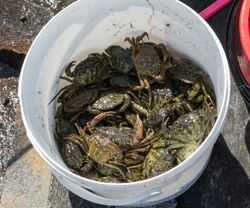Social:Crab mentality
Crab mentality, also known as crab theory,[1][2] crabs in a bucket[lower-alpha 1] mentality, or the crab-bucket effect, is a way of thinking best described by the phrase "if I can't have it, neither can you".[3] It is a term coined by Filipino journalist and writer Ninotchka Rosca in a 1987 interview published in the Philippine News; Rosca coined the term to describe how in her view the generally collectivist Filipino culture disapproves of individual success as arrogant and deplorable.[citation needed]
The metaphor is derived from anecdotal claims about the behavior of crabs when they are trapped in a bucket: while any one crab can easily start to climb out,[4] it will nonetheless be pulled back in by the others, ensuring the group's collective demise.[5][6][7]
The analogous theory in human behavior is that members of a group will attempt to reduce the self-confidence of any member who achieves success beyond the others, out of envy, jealousy, resentment, spite, conspiracy, or competitive feelings, to halt their progress.[8][9][10][11] Similar concepts are embodied in the English phrase "tall poppy syndrome" in Australia and New Zealand and in the Law of Jante, an informal code of conduct observed in the Scandinavian countries of Denmark , Sweden and Norway .
Note
- ↑ Instead of bucket - barrel, basket, or pot are all also commonly used.
See also
References
- ↑ Mae Lentz, Ella (2006). "The Crab Theory Revisited". https://www.youtube.com/watch?v=5Iy-g3fXNWA.
- ↑ Henry, Elizabeth. "FAQ: Crab Theory". https://libguides.gallaudet.edu/crab-theory.
- ↑ L. Douglas Wilder (October 1, 2015). Son of Virginia: A Life in America's Political Arena. Lyons Press. p. 185. ISBN 978-1-4930-1952-6. https://books.google.com/books?id=dMZwCgAAQBAJ&pg=PA185.
- ↑ Low Robin Boon Peng (2016). Good Intentions Are Not Enough: Why We Fail At Helping Others. World Scientific. p. 104. ISBN 978-981-320-059-3. https://books.google.com/books?id=gmltDQAAQBAJ&pg=PA104.
- ↑ Sudipta Sarangi (April 1, 2013). "Capturing Indian 'Crab' Behaviour". The Hindu. http://www.thehindubusinessline.com/opinion/capturing-indian-crab-behaviour/article4570414.ece.
- ↑ Miller, Carliss D. (January 2015). "A Phenomenological Analysis of the Crabs in the Barrel Syndrome". Academy of Management Proceedings 2015 (1): 13710. doi:10.5465/AMBPP.2015.13710abstract.
- ↑ Adams, Frank Patrick (December 2019). Does the Crab Theory Hold Water? Investigating Intragroup Discriminatory Attitudes within the Deaf Community (PDF) (PhD). Gallaudet University. OCLC 1226710162. Archived from the original (PDF) on 2020-10-17. Retrieved 2020-07-28.
- ↑ Manuel B. Dy (March 3, 1994). Values in Philippine Culture and Education. Council for Research in Values and Philosophy. p. 40. ISBN 978-1-56518-041-3. https://books.google.com/books?id=hRoYc2hPg2sC&pg=PA40.
- ↑ Herbert A. Leibowitz (December 31, 1994). Parnassus: Twenty Years of Poetry in Review. University of Michigan Press. p. 262. ISBN 978-0-472-06577-6. https://books.google.com/books?id=hydg0bdWd2cC&pg=PA262.
- ↑ Albert Shanker (June 19, 1994). "Where We Stand: The Crab Bucket Syndrome". The New York Times. http://source.nysut.org/weblink7/DocView.aspx?id=1012.
- ↑ David, E. J. R. (2013). Brown Skin, White Minds: Filipino / American Postcolonial Psychology. Charlotte, NC: Information Age Publishing. pp. 119. ISBN 978-1-62396-209-8.
Further reading
- Aydin, Gizem Zevde; Oğuzhan, Gülpembe (2019). "The 'Crabs in a Bucket' Mentality in Healthcare Personnel: A Phenomenological Study". Hitit Üniversitesi Sosyal Bilimler Enstitüsü Dergisi 12 (2): 618–630. https://www.ceeol.com/search/article-detail?id=886508.
- Caples, Ceo (14 February 2018). "Does the 'Crabs in a Bucket Syndrome' still exist?". Medium. https://medium.com/@CEOCaples/does-the-crabs-in-a-bucket-syndrome-still-exist-written-by-derrick-ceo-caples-4b823b2297ff.
- Bergthold, Linda (1984). "Crabs in a Bucket: The Politics of Health Care Reform in California". Journal of Health Politics, Policy and Law 9 (2): 203–222. doi:10.1215/03616878-9-2-203. PMID 6386960.
- Sampath, Niels (June 1997). "'Crabs in a bucket': Reforming male identities in Trinidad". Gender & Development 5 (2): 47–54. doi:10.1080/741922352. PMID 12292616.
- Klein, Alan (2020). "'Crabs in a Bucket': Envy and Egalitarianism in a Lakota World". Lakota Hoops. pp. 156–173. doi:10.36019/9781978804081-008. ISBN 978-1-9788-0408-1.
- Bulloch, Hannah C. M. (April 2017). "Ambivalent moralities of cooperation and corruption: Local explanations for (under)development on a Philippine island". The Australian Journal of Anthropology 28 (1): 56–71. doi:10.1111/taja.12173.
- Thibodeau, Regan (2019). Dynamics of Deaf Leadership: A Theoretical Model (Thesis). OCLC 1109395250.
 |


